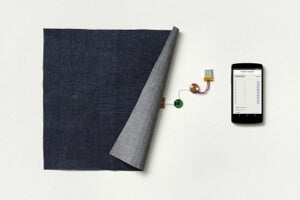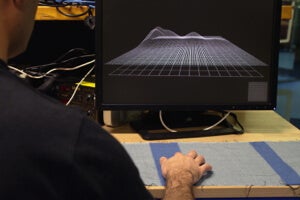Wearable technology is the future. There’s just one problem. No one wants to wear the stuff.
One potential solution? Make it invisible. Weave it into already existing products so seamlessly no one will even know it’s there—unless they need it. This is the inspiration behind Google’s Project Jacquard, led by one of the firm’s skunkworks, ATAP, and recently announced and demoed at the annual Google I/O developer conference in San Francisco.
By weaving conductive metal threads into fabric, Google says they can transform your pants into a touchpad. Or your shirt. Or anything made of fabric. Car seats, sofas, chairs, hideous Christmas sweaters…underwear? Maybe not.

The conductive cloth is, according to Google, “indistinguishable” from regular fabric, comfortable, controlled by a chip the size of a jacket button, senses touch like a smartphone screen (although it isn’t quite as sensitive), and can even infer gestures using machine learning algorithms. These can be communicated to external devices wirelessly.
It’s probably too early to speculate on how much an item of clothing like this might cost. But Google calls the necessary components “cost-efficient” and the fabric—including materials like silk, cotton, and polyester—can be produced on the standard machines we use for textiles today. This is important. Conductive fabrics aren’t new, but reliably making them at scale is a big next step.
The tech isn’t too power hungry, but you’d still need to charge you pants every few days. More self-sufficient iterations might harvest power from motion. You’d also want them to be selective—that is, clothing is consistently touching your body or brushing objects as you walk around.
Filtering deliberate from random touches and gestures will be key.
Apart from broadly noting that “connected clothes” can be used to interact with “services, devices, and environments,” Google isn’t planning to sort out exact applications. That, they say, will be up to developers and inventors. Instead, they’ll focus on perfecting the tech (in partnership with Levi’s) and providing a launchpad for the creativity of others.

“From a fashion designer’s perspective and wearer’s perspective, we want this to be as flexible as the stuff you already wear,” says Carsten Schwesig, design lead on Project Jacquard. “As opposed to electronics, which have a very fixed form factor and very fixed functionality.” Design first, adaptable functionality. Very good.
Google’s smart clothes are one example of a broadly connected future. We’re integrating computing into everything else too.
How will we control a smart house or office? Smartphones and tablets are likely a piece of the puzzle. And indoor tracking systems, akin to Kinect (but much more precise), will be another one. Meanwhile, conductive materials—fabrics, inks, and paints—might allow us to embed controls on any surface.
Perhaps certain dials, nobs, switches, and handles will be gradually replaced by conductive surfaces.
We like this direction because it hints at a much more seamless integration of technology. In recent years, computing has been awkwardly shuffling into our personal space. Fitness bands, smartwatches, Google Glass. Ultimately, people want this stuff to work, yes, but mostly to get out of the way.
And that’s where we’re going.
Altogether, these technologies might realize a future that looks, outwardly, a lot like the present—but where seemingly ordinary, everyday stuff can do extraordinary things.
“If you can weave the sensor into the textile, as a material,” says Google’s Ivan Poupyrev, “you’re moving away from the electronics. You’re making the basic materials of the world around us interactive.”
Image Credit: Google



